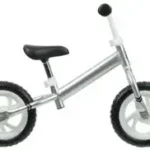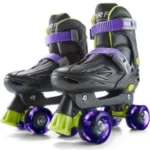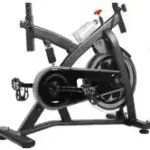Kmart Bicycle Owner’s Manual Children’s Bicycles
Item No.: 42959762
Item Name: 45CM PHANTOM BLACK BIKE
IT IS IMPORTANT TO READ THIS MANUAL THOROUGHLY BEFORE ASSEMBLING, RIDING, OR PERFORMING MAINTENANCE ON THIS BICYCLE. KEEP THIS MANUAL FOR FUTURE REFERENCE.
PARTS IDENTIFICATION
NAME OF BICYCLE PARTS
NOTE: Not all the components or all bicycle types are shown.

SAFETY PRECAUTIONS
Owner’s Safety Information and Responsibility
To reduce the risk of serious personal injury, you should read the instruction in this manual carefully.
There are ![]() WARNING throughout this manual, please follow all WARNING instructions.
WARNING throughout this manual, please follow all WARNING instructions.
![]() WARNING: This bicycle is made to be ridden by one rider at a time for general transportation and recreational use. It is not made to withstand the abuse associated with stunting and jumping.
WARNING: This bicycle is made to be ridden by one rider at a time for general transportation and recreational use. It is not made to withstand the abuse associated with stunting and jumping.
- The bicycle has been supplied partially assembled. It is the owner’s responsibility to read and follow all the assembly and adjustment instructions exactly as written in this manual. Or you may ask a vehicle mechanic to assemble this bicycle.
- Know how to operate all standard and accessory equipment on the bicycle.
- Your bicycle conforms to relevant Australian Standards. Other local bicycle regulations may apply. Check with your retailer
![]() WARNING: Read through the following Rules of the Road to reduce the injury to the rider or to others.
WARNING: Read through the following Rules of the Road to reduce the injury to the rider or to others.
Rules of the road
- Obey the road rules at all times, such as traffic signals, signs and giving way to pedestrians.
- Always wear a bicycle helmet that meets the local safety standards. Always ensure that appropriate footwear is worn whilst riding this bike. Lace-up shoes with rubber soles, never ride barefooted or in sandals, and ensure that shoelaces are tied and kept out of the way of the wheels and drive system.
- Always ride in the same direction as the traffic. Never ride against the traffic.
- Avoid the following hazards: Drain grates, soft road edges, gravel or sand, potholes or ruts, wet leaves, or uneven paving.
- When crossing railroad tracks do so carefully at a 90-degree angle to prevent loss of control.
- Do not carry packages or objects that obstruct your vision or control.
- Do not carry passengers.
- Do not ride with both hands off the handlebars.
- Use hand signals. Indicate intended actions, such as turning or stopping, by using appropriate hand signals.
- If there is a front brake, apply the rear brake first, and then apply the front brake. The front brake is strong and if not used correctly you may lose control and fall.
- Do not use items that may impede your hearing. E.g. headphones.
- Ride predictably and in a straight line.
Wet Weather
- Use extra caution in wet weather.
- Avoid sudden braking
- Apply brakes sooner in wet conditions, as stopping distance Increase in weather.
- Slow overall riding pace and approach corner more carefully.
Night Riding
Avoid riding at night if possible, if you choose to ride at night:
- Purchase, install and use a front and rear bicycle light.
- Make sure the reflectors of your bicycle are correctly positioned.
- Use a flashing rear light to improve visibility.
- Wear light-colored reflective clothing, such as a reflective vest and reflective bands for your arms and legs.

![]() WARNING: Always wear a correctly fitted and fastened helmet when riding your bicycle.
WARNING: Always wear a correctly fitted and fastened helmet when riding your bicycle.
To determine the correct size of the bicycle for the rider.
The correct frame size is the largest frame that the rider can automatically straddle 431* keeping both feet on the ground and allowing 25mm(1 inch) dearanoe(1) between the rider’s crotch and the top of the frame tube(2). The minimum leg length (3) for the rider Is the highest part of the top of the frame tube plus 1 inch.
Note Girls can use boys’ bicycles to determine the is correct frame size.
Rider must be able to straddle bicycle with at least 1 inch(2.54cm) clearance above the horizontal bar when standing.

Tools required(Not included in the packing)
Phillips head screwdriver; adjustable wrench or an 8mm, 10mm, 13mm,14mm 15mm open and box end wrenches; Allen Keys; Applier with cable cutting ability; Air pump;

Keep a Record of Your BicycleEach bicycle has a Serial Number stamped into the bottom of the frame. Write down this number to keep it for future reference. Take a color photograph of your bicycle, write the Serial number on the back of the photograph and keep it in a safe place. If you keep a record of the details of your bicycle it will greatly increase the possibility of getting it back should it be lost or stolen. Remember the advice about LOCKING YOUR BICYCLE. A good quality lock is a cheap insurance.
Safety checklist
Before riding, it is important to carry out the following safety checks:
- Nuts and bolts
Check and tighten any loose nuts, bolts, and straps. If you’re not sure, ask your bicycle retailer to check. - Brakes
Check that the brakes operate effectively. - Wheels and Tyres
Check by pushing down with your thumb on the top of the tire. The tire should depress slightly, Compare to how it feels when you know the tires are correctly Inflated. Replace damaged tires before they puncture. Spin each wheel and check for brake clearance and side—to—side wobble. If a wheel wobbles or hits the brake pads, take the bicycle to your bicycle retailer. - Handlebar and Saddle
Tighten them so they do not move and are horizontal. Check the handlebar is in good condition and the ends of the handlebar are plugged Check the bell is fitted and working well.
Warning: Handlebar grips and tube end plugs should be replaced if damaged, as bare ends have been known to cause injury. Please check the condition of grips and bar ends before the ride. - Chain
Ensure the chain is oiled, clean, and runs smoothly. - Accessories
Ensure that all reflectors are properly fitted and not obscured.
ASSEMBLY
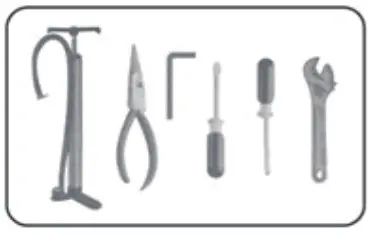
Bicycle Assembly
- Front Wheel
Assemble the front wheel to the fork as shown (Shown with the bike sitting upside-down.)
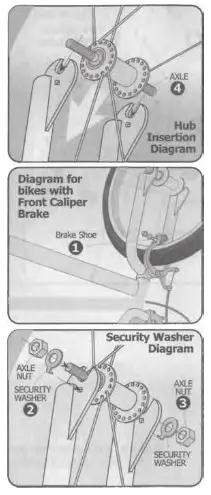 WARNING: If you remove a brake shoe to install the front wheel, return it to the correct position as written In the “Brake and cable adjustment” Section.
WARNING: If you remove a brake shoe to install the front wheel, return it to the correct position as written In the “Brake and cable adjustment” Section.
-Make sure the tab of each security washer (2) is in the hole of the fork.
-Using the two-axle nuts (3) with serrations, attach the front wheel.
 WARNING: Do not use the nuts without serrations to attach the front wheel. put the wheel in the center of the fork and tighten both nuts to the recommended torque of 25 28N.M.
WARNING: Do not use the nuts without serrations to attach the front wheel. put the wheel in the center of the fork and tighten both nuts to the recommended torque of 25 28N.M. - Training WheelAttach the legs to the bicycle frame: Put the alignment insert (1), a leg (2), and an axle nut (3) on each end of the rear wheel axle (4).Make sure the tab of the alignment insert (5), is to the rear of the axle and in the slot (6) of the frame.
Make sure both training wheels are the same distance from the ground. Tighten the axle nuts securely.
 WARNING:As your child’s ability and balance improve, you may raise or remove the training wheels. To move the training wheels loosen the nut, slide the leg to the correct position, and retighten the nut. To remove the training wheels, remove the nut, leg, and alignment insert.
WARNING:As your child’s ability and balance improve, you may raise or remove the training wheels. To move the training wheels loosen the nut, slide the leg to the correct position, and retighten the nut. To remove the training wheels, remove the nut, leg, and alignment insert.
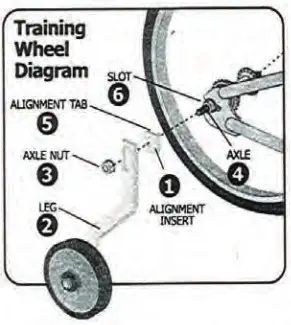
- Install Pedals
All 1. Thread the pedal marked R clockwise into the right or chain wheel side of the crank arm.
Thread the pedal marked L counter-clockwise into the left side of the crank arm.
NOTE: Hand thread pedals into position without the use of a wrench to ensure threads are not crossed threads. Damage to the crank arm will result from crossed threads. When tightening with a wrench, make sure each spindle is firmly seated against the crank arm. If the Jaws of the wrench are too thick, they may prevent proper tightening of the pedal spindle against the crank arm.
- Install Saddle
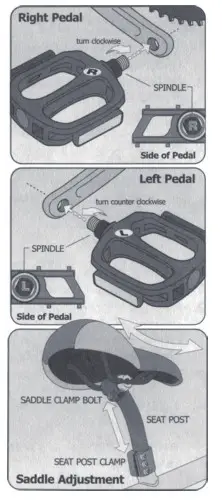 1. Insert the seat post into bicycle frame tube with small swaged end up.
1. Insert the seat post into bicycle frame tube with small swaged end up.
Note: Seat post must be inserted at least to minimum insertion mark stamped on the lower part of the post.
2. Tighten the seat post clamp nut or quick release securely. Recommended torque is 12-17N.M.
3. Loosen saddle clamp nuts or quick release so saddle clamp will ft down fully onto top swaged end of the seat post.
4. Tighten seat post bolt. Recommended torque is 12-17N.M. Note: If there is a rear reflector, please install the rear reflector to the seat post before insert to the seat tube.
Handlebar and Stem
Your bike is equipped with a “threadless” stem, which clamps onto the outside of the steerer tube of the fork.
- Assemble the stem to the fork.
The stem was usually pre-assembled and attached to the steerer tube by the factory, you may only have to tighten the bolts when you finished assembly.
 Kmart store may be able to change the handlebar height by moving height adjustment spacers from the lower part of the stem to the top part, or vice versa. Otherwise, you’ll have to get a stem of a different length or rise. Consult your Kmart store. Do not attempt to do this yourself, as it requires special knowledge.
Kmart store may be able to change the handlebar height by moving height adjustment spacers from the lower part of the stem to the top part, or vice versa. Otherwise, you’ll have to get a stem of a different length or rise. Consult your Kmart store. Do not attempt to do this yourself, as it requires special knowledge. 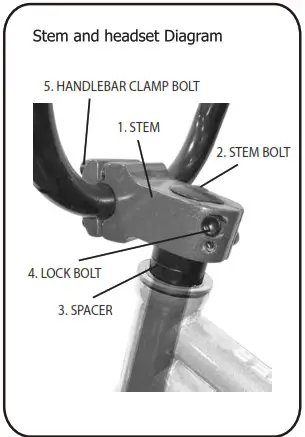 Assemble the handlebar to the stem.
Assemble the handlebar to the stem.
Loose the screws on the extended part of the stem and remove the clamp, attach the handlebar with the stress and make sure the handlebar is fixed firmly and equally and tighten the screws onto the cap and stem.
Do not tighten the bolt too much at this stage.
 WARNING: On some bicycles, changing the stem or stem height may affect the tension of the front brake cable, locking the front brake or creating excess cable slack, which can make the front brake inoperable. If the front brake blocks move in towards the wheel rim or out away from the wheel rim when the stem or stem height is changed, the brakes must be correctly adjusted before you ride the bicycle.
WARNING: On some bicycles, changing the stem or stem height may affect the tension of the front brake cable, locking the front brake or creating excess cable slack, which can make the front brake inoperable. If the front brake blocks move in towards the wheel rim or out away from the wheel rim when the stem or stem height is changed, the brakes must be correctly adjusted before you ride the bicycle.- Adjust the handlebar in a comfortable position for the rider. Tighten the bolts of the handlebar clamp. If the handlebar clamp has more than one bolt, tighten the bolts equally.
- Check and tighten all the bolts again.
- Test the tightness of the stem: Straddle the front wheel and hold it between your legs. Try to turn the front wheel by turning the handlebar. If the handlebar and stem turn without turning the front wheel, realign the stem with the front wheel. Tighten the bolt harder(about half a revolution only at a time) and do this test again, until the handlebar and stem do not turn without turning the wheel.
- Test the tightness of the handlebar. Hold the bicycle stationary and try to move the ends of the handlebar forward or backward. If the handlebar moves, loose bolts of the handlebar clamp, put the handlebar in the correct position, and tighten the bolts of the handlebar clamp tighter than before. If the handlebar clamp has more than one bolt, tighten the bolts equally. Do this test again, until the handlebar does not move in the handlebar clamp.

![]() WARNING: An insufficiently tightened stem clamp bolt, the clamping bolt may compromise the steering action, which could cause you to lose control and fall.
WARNING: An insufficiently tightened stem clamp bolt, the clamping bolt may compromise the steering action, which could cause you to lose control and fall.
4-bolt-stem instructions
Notice:
- Alight the stem in the steer tube so that the handlebar is perpendicular to the front wheel.
- Ensure the minimum insertion mark on the stem is not visible- beneath the top of the steer Btube.
- Tighten the stem bolt enough so that stem will not rotate in the steer tube.
- Check the rotation with firm pressure.
Steps:
- Adjust and tighten the handlebar in the stem.
- Tight the 4 bolts in a cross pattern, and ensure they clamp evenly.
- Tighten the handlebar clam nuts enough so that handlebar will not rotate in the stem.
Check handlebar rotation with slight pressure.

Assemble the Accessories
- Assemble the crash pad
Assemble the pads in the correct location as shown. Attach with the sewn-in Velcro fasteners. - Bella
The bell Is attached to the handlebar. Adjust the bell ring Into a comfortable place that Is easy to use when riding. - Front reflector
Put the reflector bracket onto the handlebar stem. Make sure the dear reflector is vertical, pointing toward the front of the bicycle. Tighten the screw with Phillip’s screwdriver.
 WARNING: Install the dear reflector exactly as shown or it will not operate correctly.
WARNING: Install the dear reflector exactly as shown or it will not operate correctly. - rear reflector
Assemble the red reflector onto the seat post. Make sure the red reflector is vertical, pointing toward the rear of the bicycle. Tighten the screw with Phillip’s screwdriver.
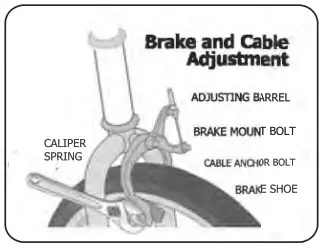
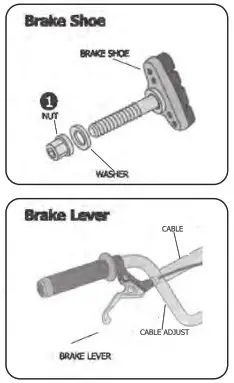
- Attach the upper cable to the brake lever. Ensure that the adjusting barrel is fully tightened in the brake lever.
- Pull the link wire on the rear brake assembly until the brake shoes are touching the rim wall and tighten the brake bolt.
- Ensure that the brake shoes are positioned evenly with the side surface of the rim.
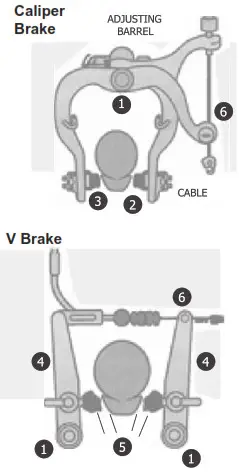
Attaching the Front Brake Cable
(For Bioickm equipped with a Front Brake)
- Open the brake lever and place the barrel end of the cable into the lever.
- Feed brake cable through cable adjuster and through anchor bolt Secure anchor bolt firmly.
- Fasten brake caliper to fork by sliding brake mount bolt through the center hole in fork. Secure brake mount bolt firmly.
- Refer to the next section for Brake System Adjustments.

ADJUSTMENT
Brake System Adjustments
![]() WARNING: You must adjust the front and rear brakes as written before you ride the bicycle
WARNING: You must adjust the front and rear brakes as written before you ride the bicycle
- Put the brake shoes In the correct position:
Loosen the nut (1) of each brake shoe. Adjust each brake shoe so it is flat against the rim and aligned with the curve of the rim. Make sure each brake shoe does not rub the tire. If the surface of the brake shoes has arrows, make sure the arrows point toward the rear of the bicycle. Hold each brake shoe in position and tighten the nut. - Test the tightness of each brake shoe:
Tiy to move each brake shoe out of position. If a brake shoe moves, do Step 1 again but tighten the nut tighter than before. Do this test again, until each brake shoe does not move. - Stretch the table:
Hold both brake shoes against the rim. Loosen the cable damp. Pull the cable tight and tighten the cable damp
![]() WARNING: Do not overtighten the cable damp. OvertightenIng the cable damp may cut the cable and cause injury to the rider or to others.
WARNING: Do not overtighten the cable damp. OvertightenIng the cable damp may cut the cable and cause injury to the rider or to others.
Squeeze each brake lever firmly 20 times. Hold both brake shoes against the rim and loosen the cable damp. Pull the cable tight and tighten the cable damp.
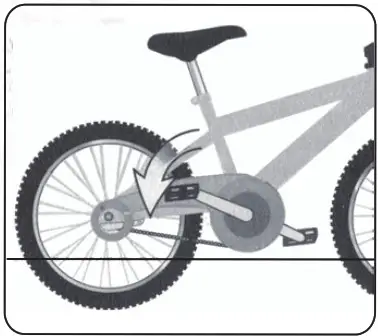
The following sections describe the final brake system adjustments required before riding. Determine which style you have and follow the instructions.
- Check the tightness of caliper brake mounting nut or V-brake mounting bolts (1):
Make sure each caliper brake mounting nut or V-brake mounting bolt is tightened securely. - Center brake shoes on rim:
If you have a V-brake, turn the cable anchor bolt (6) on the brake arm (4) to move the arm in or out so each brake shoe is the same distance from the rim (3). If you have a caliper brake, hit downward lightly on the return spring of the brake shoe (2) that is farther away from the rim. Make sure both ends of the return spring stay hooked around the inside edge or between the studs on the back of the caliper arms. Squeeze the brake lever two times. Do this step again until both brake shoes are the same distance from the rim. - Put the brake shoes the correct distance from the rim (5):
Position each brake shoe 1/16 inch away from the rim. Turn the brake lever adjusting barrel or caliper brake adjusting barrel in or out to make the adjustment. If the brake shoes cannot be positioned at the correct distance from the rim, hold both brake shoes against the rim and loosen the cable anchor bolt (6).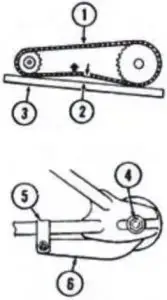 Pull or loosen the cable wire slightly. Tighten the cable damp
Pull or loosen the cable wire slightly. Tighten the cable damp
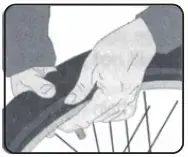 WARNING: Do not overtighten the cable damp. Overtightening the cable damp may cut the cable and cause Injury to the rider or to others.
WARNING: Do not overtighten the cable damp. Overtightening the cable damp may cut the cable and cause Injury to the rider or to others.
Do Step 3 until the brake shoes are the correct distance from the rim. Turn the locknut(s) against the brake
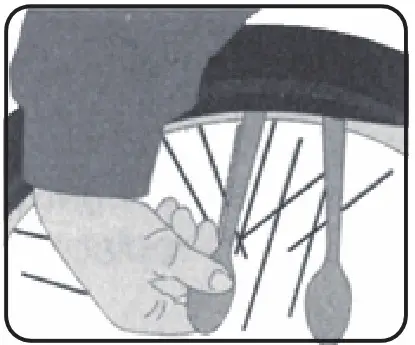 WARNING: Turn Do not move the brake shoes away from a wheel rim that Is not true (straight). This can cause the caliper brake to be Ins effective and unsafe. To allow safe adjustment of the caliper brake, have a bicycle service shop true the wheel.
WARNING: Turn Do not move the brake shoes away from a wheel rim that Is not true (straight). This can cause the caliper brake to be Ins effective and unsafe. To allow safe adjustment of the caliper brake, have a bicycle service shop true the wheel.
- Check sheath position:
Make sure both ends of the sheath are fully recessed in the brake lever, sheath stops (If equipped), and brakes. If not, Install sheath incorrect position and do Step 3 again. Do this test again, until the sheath is in the correct position. - Test the tightness of the cable clamp:
Squeeze each brake lever with firm pressure. Make sure the cable does not move in the cable clamp. If the cable moves in the cable damp, do Steps 3 and 4 again but tighten the cable clamp tighter than before. Do this test again, until the cable does not move in the cable damp. - Adjust the brake lever reach so the distance from the grip Is comfortable to the rider.
Turn the adjustment screw (if equipped) to change the distance of the brake lever from the grip. Make sure the back of each grip is no more than 3 inches from the front of each brake lever. - Test the travel of each brake lever:
Squeeze each brake lever with strong pressure. If the brake lever touches the grip, do Steps 1 through 7 again.
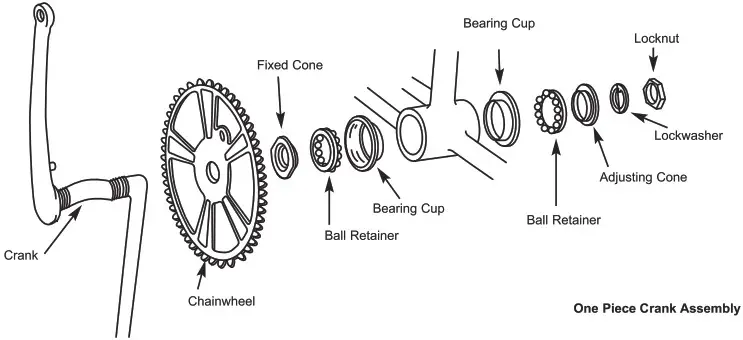 WARNING: After you do Steps 1 through 7 again if either brake lever touches the grip or does not work well, have a bicycle service shop repair or adjust the caliper or cantilever brakes.
WARNING: After you do Steps 1 through 7 again if either brake lever touches the grip or does not work well, have a bicycle service shop repair or adjust the caliper or cantilever brakes.
Reducing Caliper Brake Noise (Caliper Brake Only)
It is common for caliper brakes to make noise or “squeak” when in use. This noise does not Normally indicate a brake problem. Following the instructions below may reduce the noise:
Make sure the caliper brakes are adjusted correctly. Using a small adjustable wrench, bend each caliper arm so the front edge of each brake shoe is the first part to touch the rim.
 WARNING: Bend each caliper only a small amount If you bend the caliper arm too far, the caliper brake can be damaged and the performance of the caliper brake is reduced.
WARNING: Bend each caliper only a small amount If you bend the caliper arm too far, the caliper brake can be damaged and the performance of the caliper brake is reduced.
Brake System Operation
Operate the brakes as follows:
Squeeze the brake lever on the handlebar. The brake lever pulls on a cable that is attached to the brake. The brake squeezes the rim between two brake shoes.
Operate the brakes by slowly and continuously squeezing both brake levers until you feel the braking action. Make a habit of always using both brakes to stop the bicycle. You will stop In the shortest distance by using both brakes.
![]() WARNING: If you do not obey the following instructions, injury to the rider or to others can occur:
WARNING: If you do not obey the following instructions, injury to the rider or to others can occur:
Before you ride the bicycle for the first time, check and adjust the brakes as written in the “Adjustments” section. Then test the brakes and practice using them at low speed in a large and level area that is free of obstruction. If the brake block is worn, please replace the worn brake block as per the instructions of “Brake System Adjustment”(Page 15) When correctly used, the brake system is very effective. But, if you apply the front brake too strongly, you can be thrown off the bicycle. Make a habit of always using both brakes to stop the bicycle.
Always try to break while going in a straight line. Apply brakes earlier in the following conditions: wet pavement, sand, gravel, leaves, or if you need to brake while turning. To reduce the chance of skidding apply brakes intermittently.
If the rims are wet, start to brake earlier than normal because a longer distance to stop the bicycle will be necessary.
Be careful when riding downhill or at a high speed because as your speed increases, a longer distance to stop the bicycle will be necessary. Slow for curves because too much speed can force you to make a turn too wide.
Keep wax, oil, grease, etc. off the rims and the brake shoes. These lubricants will reduce brake performance and a longer distance to stop the bicycle will be necessary.
Check and adjust the brakes the first time they do not stop the bicycle quickly and smoothly, do not stop the bicycle as well as they have in the past, or if either brake lever can touch the grip.
Coaster Brake
![]() APPLY PRESSURE TO CS) SLOW DOWN OR STOP
APPLY PRESSURE TO CS) SLOW DOWN OR STOP
The coaster brake is a sealed mechanism, which is a part of the bicycle’s rear wheel hub. The brake is activated by reversing the rotation of the pedal cranks (see the coaster brake diagram). Start with the pedal cranks in a nearly horizontal position, with the front pedal in about the 4 o’clock position, and apply downward foot pressure on the pedal that is to the rear. The more downward pressure you apply, the more braking force, up to the point where the rear wheel stops rotating and begins to skid.
![]() CAUTION: Before riding, make sure that the brake is working properly. If it is not worlded properly. have the bicycle checked by your dealer before you ride it.
CAUTION: Before riding, make sure that the brake is working properly. If it is not worlded properly. have the bicycle checked by your dealer before you ride it.
Adjusting your coaster brake
Coaster brake service and adjustment require special tools and special knowledge. Do not attempt to disassemble or service your coaster brake. Take the bicycle to your dealer for coaster brake service.

APPLY PRESSURE TO SLOW DOWN OR STOP
Repair and Service
![]() WARNING: Inspect the bicycle frequently. Failure to inspect the bicycle and to make repairs or adjustments, as necessary can result in injury to the rider or to others. Make sure all parts are correctly assembled and adjusted as written in this manual and any Special Instructions
WARNING: Inspect the bicycle frequently. Failure to inspect the bicycle and to make repairs or adjustments, as necessary can result in injury to the rider or to others. Make sure all parts are correctly assembled and adjusted as written in this manual and any Special Instructions
Rear Wheel and Chain Adjustment
Maintenance: The chain must be at the correct lightness. If too tight, the bicycle will be difficult to pedal. If too loose, the chain can come off the sprockets.
![]() WARNING: The chain must remain on the sprockets. If the chain comes off the sprockets, the coaster brake will not operate.
WARNING: The chain must remain on the sprockets. If the chain comes off the sprockets, the coaster brake will not operate.
When the chain (1) is at the correct lightness, you can pull it one-half inch (2) away from a straightedge (3) as shown. Adjust the tightness of the chain as follows: Loosen the axle nuts (4) of the rear wheel. Loosen the damp (5) on the brake arm(6), but do not remove the nd and screw from the clamp.
NOTE: Make sure that the rear wheel Is in the center of the bicycle frame.
Move the rear wheel forward a backward as necessary, until you can pull the chain on half-inch away from a straightedge, Hold the wheel In the position and tighten the axle nuts to the recommended torque of 2S-16ti.m.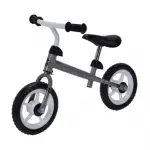
TYRE REMOVAL
- Let the air out of the tire by depressing the valve core (the little pin in the center of the valve stem opening).
- Separate the tire bead from the sides of the rim by pressing with your thumbs. Work your way around the tire on both sides to be sure that the beads of the tire are not sticking to the rim. (Figure A)
FIGURE A Press we, thumbs to separate tire bead. Continue around the entire ran and the bead is carpet* separated.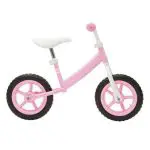
- Stand the wheel upon the firm surface with the valve stem on the bottom and grasp the upper part of the tire with both hands. Try to roll the tire off the far side of the rim.
- With the wheel standing as in Figure B, use bicycle tire tools for spoon handles with rounded ends (at least two-preferably three) to lift the bead on one side of the tire off the rim. Be careful not to pinch the inner tube between the tire tools and the tire bead or rim. Once you have got the bead off for about one-fourth of the circumference of the tire using the tools, the rest can usually be pulled off by hand.
FIGURE B IS Lift bead with spoons or tire tools.
- With the bead on one side of the tire completely off the rim, you can now pull the inner tube out from between the tire and rim everywhere except in they are of the valve stem.
FIGURE C replaces tire onto nm.
- It should now be easy to pull the tire the rest of the way off the rim. Start at the side of the wheel opposite the valve stem and simply lift the bead of the tire up over the side of the rim and pull it off.
FIGURED D Rims ship protectsimer tube (ran spoke ends.
FIGURE F Use thin* to pass valve gem through a hole in the rim. Make aerial, the valve stem is straight

Frequently check the tire inflation pressure because all tires lose air slowly over time. For extended storage, keep the weight of the bicycle off the tires.
Inflation: maintain tire pressure at the level recommended on the tire sidewalls.
Conversion from PSI to kilopascals is listed below: 40PSI=275Kpa 35PSI=241Kpa
![]() WARNING: Do not ride or sit on the bicycle if either inner tube is underinflated. This can damage the tire and inner tube. Do not use unregulated air hoses to inflate the inner tubes. An unregulated hose can suddenly overinflate bicycle tires and cause them to burst.
WARNING: Do not ride or sit on the bicycle if either inner tube is underinflated. This can damage the tire and inner tube. Do not use unregulated air hoses to inflate the inner tubes. An unregulated hose can suddenly overinflate bicycle tires and cause them to burst.
Use a hand or a foot pump to inflate the inner tubes. Service station meter-regulated air hoses are also acceptable. The correct inflation pressure is shown on the tire sidewall.
Before adding air to any tire, make sure the edges of the tire (the bead) are the same distance from the rim, all around the rim, on both sides of the tire. If the tire does not appear to be seated correctly, release air from the inner tube until you can push the bead of the tire into the rim where necessary, add air slowly, and stop frequently to check the tire sealing and the pressure until you reach the correct inflation pressure as indicated on the tire sidewall. Replace worn or defective tires and inner tubes.
Recommended torque requirement
(A)Front axle nuts:25-28N.M
(B) back axle nuts:25-28N.M
(C) Handlebar clamp nut/bolt(4 bolt type):9-13N.M (1 bolt type):21-25N.M
(D) Handlebar stem expander bolt:17-19N.M (E) seat pillar clamp nut/bolt:12-17N.M
(F) brake cable anchor bolt:7-11N.M
(G) brake mounting bolt:6-8N.M
(H) Seat clamp nuts:12-17N.M
(I) crank attachment systems:24-30N.M
It is recommended that a torque wrench be used during the assembly bicycle.
Inspection of Bearings
Maintenance: Frequently check the bearings of the bicycle. Have a bicycle service shop lubricate the bearings once a year or any time they do not pass the following tests.
Head Tube Bearings: The fork should turn freely and smoothly at all times. With the front wheel off the ground, you should not be able to move the fork up, down, or side-to-side in the head tube.
Crank bearings: The crank should turn freely and smoothly at all times and the front sprockets should not be loose on the crank. You should not be able to move the pedal end of the crank from side to side.
Wheel bearing: Lift each end of the bicycle off the ground and slowly spin the raised wheel by hand. The bearings are correctly adjusted if: The wheel spins freely and easily. The weight of the spoke reflector when you put it toward the front or rear of the bicycle causes the wheel to spin back and forth several times. There is no side-to-side movement at the wheel rim then you push it to the side with light force.
Lubrication/ Maintenance
![]() WARNING: Do not over-lubricate. If oil gets on the wheel rims or the brake shoes, it will reduce brake performance, and a longer distance to stop the bicycle will be necessary. Injury to the rider or to others can occur.
WARNING: Do not over-lubricate. If oil gets on the wheel rims or the brake shoes, it will reduce brake performance, and a longer distance to stop the bicycle will be necessary. Injury to the rider or to others can occur.
The chain can throw excess oil onto the wheel rim. wipe excess oil off the chain.
Keep all oil off the surfaces of the pedals where your feet rest.
Using soap and hot water wash all oil off the wheel rims, the brake shoes, the pedals, and the tires. Rinse with clean water and dry completely before you ride the bicycle.
Using a light machine oil (20W) and the following guidelines, lubricate the bicycle:
| What | When | How |
| Brake Levers | every six months | Put one drop of oil on the pivot point of each brake lever |
| Caliper brakes | every six months | Put one drop of oil on the pivot point of each caliper brake |
| Brake Cables | every six months | Put four drops of oil into both ends of each cable. Allow the oil to soak back along the cable wire. |
| Pedals | every six months | Put four drops of oil where each pedal axle goes into the pedal. |
| Chain | every six months | Put one drop of oil on each roller of the chain. Wipe all excess oil off the chain. |
Normal Repair Kits
Some parts of the bicycle will be easily worn Below are the normal repair kits for future use.
- Spare inner tube ;
- Patch kits
- Pump
- Tire levers
- Multi-tools
It is recommended that significant mechanical repairs should be carried out by a skilled bicycle mechanic.

WHEELS
Wheel inspection
It is most important that wheels are kept in top condition. Properly maintaining your bicycle’s wheels will help braking performance and stability when riding. Beware of the following potential problems:
Dirty or greasy rims:
Caution: these can render your brakes ineffective. Do not clean them with oily or greasy material. When cleaning, use a clean rage or wash with soapy water, rinse and air dry, don’t ride while they’re wet.
When lubricating your bicycle, don’t get oil on the rim braking surfaces.
Wheels not straight:
Lift each wheel off the ground and spin them to see if they are crooked or out of round. If wheels are straight, they will need to be adjusted. This is quite difficult and is best left to a bicycle specialist.
Broken or loose spokes: Check that all spokes are tight and that none are missing or damaged.
Caution: such damage can result in severe instability and possibly an accident if not corrected.
Again, bicycle specialist beat handle spoke repairs.
Loose hub bearings:
Lift each wheel off the ground and try to move the wheel from side to side.
Caution: if there is movement between the axle and the hub, do not ride the bicycle. Adjustment is required.
Axle nut
Check that these are tight before each ride.
Fork replacement:
If you choose to replace the front fork, please ensure that the fork is the same size and inner tube diameter as the original fork that was sold with the bicycle.
Lubrication and Adjustment — One-Piece Cranks
To adjust the free play in a one-piece type bottom bracket, loosen the locknut on the left side by turning it clockwise and tighten the adjusting cone counter-clockwise using a screwdriver in the slot. When correctly adjusted, re•tighten the locknut counter-clockwise. To disassemble
- Remove the chain from the chain wheel
- Remove the left pedal by turning the spindle clockwise
- Remove the left side locknut by turning it clockwise and removing the keyed lock washer.
- Remove the adjusting cone by turning it clockwise with a screwdriver.
- Remove the left ball retainer, slide the crank assembly out of the frame to the right, and remove the right ball retainer. Clean and inspect all bearing surfaces and ball retainers, and replace any damaged parts. Pack the ball bearing retainers with grease, then re-assemble in the reverse of the above proceed

WARRANTY
12 Month Warranty
Thank you for your purchase from Kmart.
Kmart Australia Ltd warrants your new product to be free from defects in materials and workmanship for the period stated above, from the date of purchase, provided that the product is used in accordance with accompanying recommendations or instructions where provided. This warranty is in addition to your rights under the Australian Consumer Law.
Kmart will provide you with your choice of a refund, repair, or exchange (where possible) for this product if it becomes defective within the warranty period. Kmart will bear the reasonable expense of claiming the warranty. This warranty will no longer apply where the defect is a result of alteration, accident, misuse, abuse, or neglect.
Please retain your receipt as proof of purchase and contact our Customer Service Centre on 1800 124 125 (Australia) or 0800 945 995 (New Zealand) or alternatively, via Customer Help at Kmart.com.au for any difficulties with your product. Warranty claims and claims for expenses incurred in returning this product can be addressed to our Customer Service Centre at 690 Springvale Rd, Mulgrave Vic 3170.
Our goods come with guarantees that cannot be excluded under the Australian Consumer Law. You are entitled to a replacement or refund for a major failure and compensation for any other reasonably foreseeable loss or damage. You are also entitled to have the goods repaired or replaced if the goods fail to be of acceptable quality and the failure does not amount to a major failure.
For New Zealand customers, this warranty is in addition to statutory rights observed under New Zealand legislation
